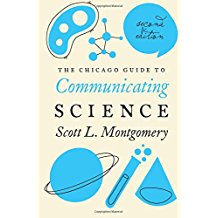Book Review of The Chicago Guide to Communicating Science, 2nd ed, by Scott L. Montgomery (University of Chicago Press; 2017)Science exists because scientists are writers and speakers -- Scott L. Montgomery Scott Montgomery’s goal in The Chicago Guide to Communicating Science is to help scientists write and speak about their science competently and even creatively. The book is divided into 3 parts. Part 1 focuses on writing well. Part 2 discusses the types of scientific communication: scientific papers, review articles, proposals, and even graduate theses. Part 3 branches out into special topics such as writing as a scientist for whom English is a second language, communicating with the public, and teaching science communication. Choosing and Using ModelsIt is often said that good writers are good readers. Reading widely allows one to develop an ear for what sounds correct. Montgomery suggests that one way to learn how to write a scientific paper well is to collect and study other well-written papers. He refers to this as choosing and using models. Here are some of Montgomery’s ideas on choosing models:
Once you have collected some models to study, here are some of Montgomery’s tips on using your models:
Tips on Getting StartedEvery book or article on writing has a different tip for how to start writing a research article: start with the Results section, write the Abstract last, start with the Methods. Montgomery suggests starting with the title. Montgomery's advice includes jotting down several phrases to describe your topic. Or, sit down with a colleague and describe your subject. This will force you to clarify your ideas. You may even come up with a few great lines to use in your article. Creative WritingChapter 5 is a gold mine of ideas on writing creatively. The chapter is titled “Writing Very Well: Opportunities for Creativity and Elegance.” Montgomery argues that “all forms of persuasive writing can be shaped creatively” and he offers 9 illustrated examples. One example shows how using a question can add emphasis or provide a transition within a paragraph: Cholesterol and related sterols are not uniformly distributed within the membranes of eukaryotic cells. Why is this so? Here we seek an answer by considering the effects of these flat, disc-like molecules on lipid bilayers. Another example draws attention to the use of alliteration, the repetition of a letter or sound at the beginning of adjacent words: This report pays special attention to the growing mass of plastic pollution that now plagues the world’s oceans. Components of a Journal ArticleChapter 9 summarizes the parts of a research article, from the title to the acknowledgments and supplementary material. Chapter 12 presents useful information on graphics, such as when to use a table and when to use a figure. Numerous examples are included and dissected. Montgomery also adds a few paragraphs on useful and rarely given information for authors about how to actually write about the figure in the text: where do you insert the figure callout? Should the figure be referenced at the beginning of the sentence or at the end? Montgomery writes, Too many authors, when it comes to indirect mention (in parentheses), jump the gun and insert the reference before the reader is ready. Examples abound in the literature. Here’s one: A Cure for Writer’s BlockMontgomery suggests rereading your models or discussing your topic with a colleague as ways to deal with writer’s block. I suggest picking up this book. A quick reread of any one of the chapters mentioned should help you unlock your inner creative writer.
|
AuthorJennifer Holmes Archives
January 2023
|
